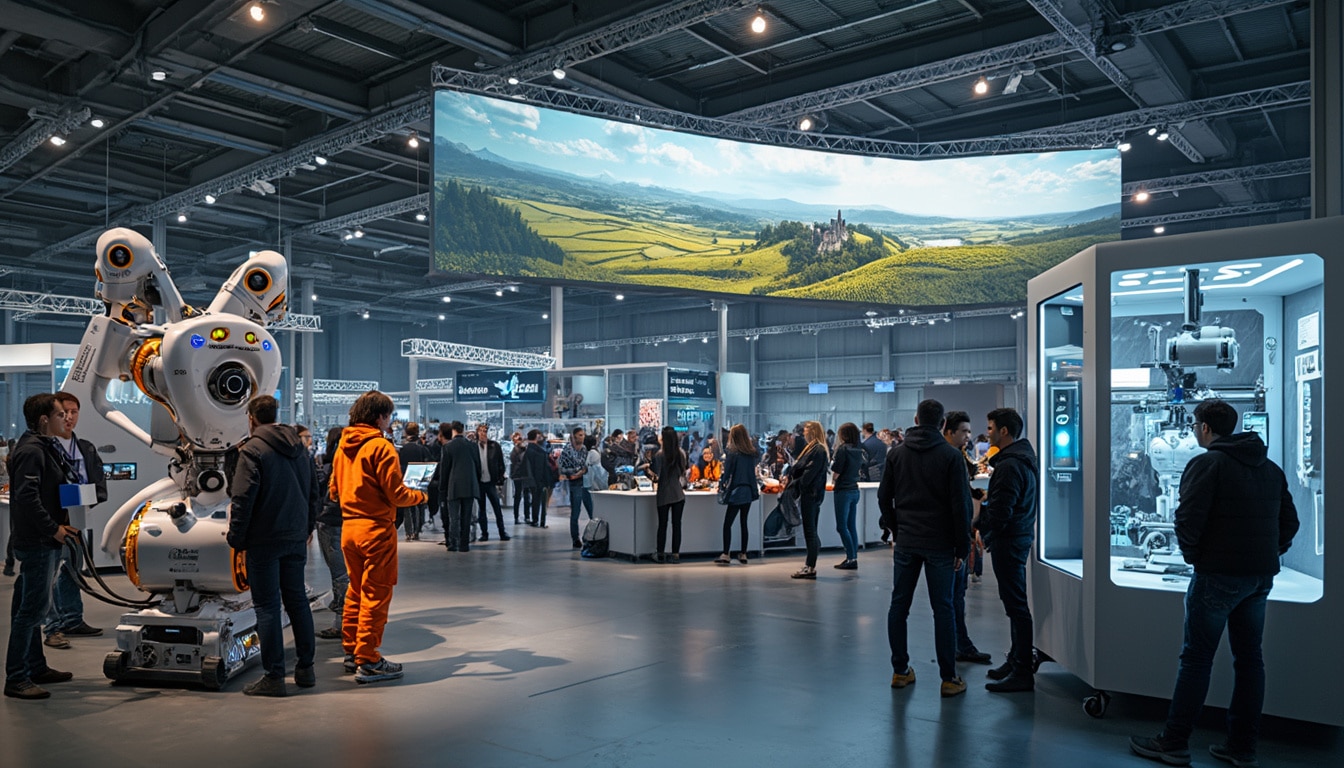Technology is advancing at a breakneck pace, leaving many decision-makers feeling like they’re navigating a tech tsunami. From generative AI to quantum computing, the landscape is both exhilarating and overwhelming. Enter the ESSEC’s Digital Disruption Matrix, a groundbreaking tool designed to bring clarity to this chaos.
In an era where trends come and go faster than you can say « blockchain, » understanding which technologies truly hold disruptive potential is crucial. The Digital Disruption Matrix serves as a strategic compass, helping leaders identify and invest in innovations that will shape the future. With insights from experts like Jérémy Beaufils, this matrix evaluates the impact of six key technologies across eleven industries. Whether it’s the cultural revolution sparked by generative AI or the pragmatic skepticism surrounding blockchain in the automotive sector, the matrix provides a nuanced view of the technological terrain. As we delve deeper, we’ll explore how these technologies are not just changing industries, but also redefining our societal norms and business strategies. Buckle up, because the journey through digital disruption is anything but dull.

Table of contents
ToggleWhy is energy becoming a critical bottleneck for innovation?
In today’s rapidly evolving technological landscape, energy has emerged as the new bottleneck for innovation. As industries push the boundaries of what’s possible, the demand for energy-intensive technologies such as artificial intelligence, blockchain, and quantum computing continues to surge. This heightened energy demand strains existing infrastructure and resources, making it increasingly challenging for innovators to sustain growth and development. The Digital Disruption Matrix by ESSEC’s Digital Disruption Chair highlights that the proliferation of technologies like IA générative (generative AI) is not just a technical leap but a cultural revolution that requires substantial energy to maintain and expand.
Historically, barriers to innovation included limited computational power and data access. However, advancements have mitigated these issues, shifting the focus to energy availability and sustainability. As Jeremy Beaufils, Executive Director of the Digital Disruption Matrix, points out, the surge in energy consumption by cutting-edge technologies poses significant challenges. The reliance on energy not only affects operational costs but also impacts the environmental footprint of technological advancements. Without addressing these energy constraints, the pace of innovation could slow, hindering progress across various sectors.
Moreover, the global push towards renewable energy solutions underscores the urgency of resolving energy bottlenecks. As countries and companies strive to balance innovation with sustainability, the interplay between energy availability and technological advancement becomes increasingly complex. The need for scalable, efficient, and sustainable energy sources is paramount to ensure that innovation continues to thrive without compromising environmental integrity.
In which industries is energy limitation most impactful?
Energy limitations significantly impact a variety of industries, each grappling with unique challenges and opportunities. The automotive sector, for instance, faces substantial energy demands in the production and operation of electric vehicles (EVs). The transition to EVs requires not only the development of efficient batteries but also the establishment of robust charging infrastructures, both of which are energy-intensive processes. As Jeremy Beaufils notes, the automotive industry’s long development cycles and complex supply chains make the integration of new technologies like blockchain both risky and resource-heavy.
The luxury industry also experiences a dichotomy in energy usage. While there is immense potential for hyperpersonalization of products and services through AI, the energy required to process vast amounts of customer data and create bespoke experiences can be daunting. Additionally, the perception of luxury hinges on authenticity and rarity, which can be undermined by the mass production capabilities of AI-driven technologies. Balancing brand integrity with energy-intensive innovation presents a significant challenge for luxury brands aiming to stay competitive.
Furthermore, the healthcare sector relies heavily on energy for advanced medical technologies and surgeries. Innovations such as presbyopia surgery, like those emerging from Nantes, showcase how critical energy is in performing complex procedures with precision and reliability. The ability to deploy cutting-edge medical technologies consistently depends on stable and sustainable energy sources, making energy a pivotal factor in healthcare innovation.
These examples illustrate that energy limitations are not confined to a single industry but are a pervasive challenge influencing diverse sectors. Addressing energy constraints is essential for sustaining innovation and achieving long-term growth across the board.
What are the emerging solutions to the energy bottleneck?
To overcome the energy bottleneck, several emerging solutions are being explored and implemented across industries. One promising avenue is the development of renewable energy technologies, which offer sustainable alternatives to traditional energy sources. Innovations in solar, wind, and hydroelectric power are making renewable energy more accessible and cost-effective, thereby reducing the dependency on fossil fuels and mitigating the environmental impact of energy consumption.
Additionally, advancements in energy storage are crucial for balancing energy supply and demand. Breakthroughs in battery technology, such as those seen in Breton companies innovating to heat hotels while saving energy, provide efficient storage solutions that can store excess energy generated during peak production times for later use. This not only enhances energy reliability but also supports the integration of intermittent renewable energy sources into the power grid.
Another critical solution is the implementation of energy-efficient technologies within industrial processes. By optimizing energy usage and reducing wastage, industries can significantly lower their overall energy consumption. For instance, smart grid technologies and advanced automation systems enable precise energy management, ensuring that energy is utilized more effectively and sustainably.
Moreover, innovative approaches such as waste heat recovery and cogeneration are being adopted to maximize energy efficiency. These methods capture and repurpose energy that would otherwise be lost, providing a dual benefit of reducing energy costs and lowering carbon emissions.
Finally, policy initiatives and government support play a vital role in addressing the energy bottleneck. Incentives for renewable energy adoption, research and development funding, and regulatory frameworks that promote energy efficiency are essential for fostering an environment conducive to sustainable innovation. Collaborative efforts between the public and private sectors are necessary to drive the transition towards a more energy-resilient future.
How are renewable energies transforming the innovation landscape?
Renewable energies are fundamentally transforming the innovation landscape by providing sustainable and scalable solutions to the growing energy demands of modern technologies. The shift towards renewable energy sources such as solar, wind, and hydroelectric power is enabling industries to pursue innovation without the looming threat of energy shortages or exorbitant costs. This transformation is not only crucial for environmental sustainability but also for maintaining the momentum of technological advancements.
One notable impact of renewable energies is the facilitation of green technology development. As industries adopt renewable energy, they are incentivized to develop technologies that are both energy-efficient and environmentally friendly. For example, the Breton company’s innovation in heating hotels while saving energy exemplifies how renewable energy can drive the creation of sustainable solutions that meet industry needs while minimizing environmental impact.
Furthermore, renewable energy sources are fostering greater energy independence and security. By reducing reliance on centralized power grids and fossil fuels, industries can ensure a more stable and resilient energy supply. This decentralization of energy generation also spurs innovation in energy management and storage technologies, as businesses seek to optimize the use of locally generated renewable energy.
Additionally, the integration of renewable energies into the innovation ecosystem is spurring economic growth and job creation. Investments in renewable technologies not only stimulate technological advancements but also create new markets and opportunities for employment in sectors such as manufacturing, installation, and maintenance of renewable energy systems.
The convergence of renewable energy and technological innovation is thus creating a synergistic effect, where advancements in one area propel progress in the other. This dynamic interplay is essential for achieving long-term sustainability and fostering a culture of continuous innovation.
Can policy and investment alleviate energy constraints?
Policy and investment are pivotal in alleviating energy constraints and enabling sustained innovation. Governments and regulatory bodies play a crucial role in creating frameworks that support the development and adoption of renewable energy and energy-efficient technologies. By implementing policies that incentivize clean energy investments, such as tax breaks, subsidies, and grants, governments can accelerate the transition to sustainable energy sources and reduce the financial burden on businesses seeking to innovate.
Investment in research and development (R&D) is equally important. Funding for R&D initiatives can drive the discovery of new energy technologies and improve existing ones, making them more efficient and cost-effective. Innovations like zero-knowledge proofs and photonics, which Jeremy Beaufils mentions as emerging technologies in his discussions, rely on significant R&D investments to reach their full potential and address complex energy challenges.
Moreover, public-private partnerships are essential for bridging the gap between research and commercialization. Collaborative efforts between governments, academic institutions, and private enterprises can facilitate the sharing of knowledge, resources, and expertise, fostering an environment where innovative energy solutions can thrive. For example, initiatives like the Europe for Science Summit highlight the importance of bringing together diverse stakeholders to drive scientific and technological advancements.
Additionally, strategic investments in infrastructure are crucial for supporting energy innovation. Upgrading power grids, expanding renewable energy installations, and developing advanced energy storage systems require substantial capital. Governments and investors must prioritize these infrastructure projects to ensure that the necessary energy resources are available to support ongoing and future innovations.
Finally, creating a stable and predictable policy environment is essential for attracting long-term investments in energy technologies. Clear regulations and consistent policy frameworks provide businesses with the confidence to invest in sustainable energy solutions, knowing that their efforts will be supported and rewarded over time.
In summary, effective policies and robust investment strategies are fundamental to overcoming energy constraints and fostering an ecosystem where innovation can flourish unabated.
Which companies are leading the charge in energy innovation?
Several companies are at the forefront of energy innovation, driving progress through groundbreaking technologies and sustainable practices. One such company is a Breton enterprise that has developed an innovative solution to heat hotels while saving energy. This innovation not only reduces energy consumption but also lowers operational costs, showcasing the potential of sustainable technologies to transform traditional industries.
Innovative startups and established corporations alike are making significant strides in renewable energy and energy efficiency. For instance, companies focused on developing advanced battery technologies and energy storage solutions are pivotal in addressing the intermittent nature of renewable energy sources. By enhancing energy storage capabilities, these companies enable more reliable and consistent energy supplies, which are essential for sustaining high-energy-consuming technologies.
Moreover, tech giants are investing heavily in green technologies to reduce their carbon footprint and promote sustainability. Initiatives aimed at improving energy efficiency in data centers, increasing the use of renewable energy in operations
, and developing smart grid technologies are prime examples of how large corporations are contributing to energy innovation. These efforts not only benefit the environment but also drive technological advancements that can be leveraged across various industries.
Startups focusing on medical technologies are also making waves by integrating energy-efficient solutions into their products and services. These innovations ensure that high-tech medical equipment operates reliably while minimizing energy consumption, which is crucial for both cost-efficiency and sustainability in healthcare.
Additionally, collaborative ventures between different sectors are fostering a multidisciplinary approach to energy innovation. Partnerships between tech companies, energy firms, and academic institutions are resulting in the development of holistic solutions that address complex energy challenges from multiple angles. This collaborative spirit is essential for creating comprehensive energy strategies that can support sustained innovation.
These leading companies exemplify the diverse approaches being taken to tackle energy constraints and highlight the importance of innovation in overcoming one of the most pressing challenges of our time.
What role do renewable energy sources play in alleviating innovation bottlenecks?
Renewable energy sources are instrumental in alleviating innovation bottlenecks by providing sustainable and scalable power solutions that meet the increasing energy demands of modern technologies. The integration of renewables such as solar, wind, and hydroelectric power into the energy grid offers a reliable alternative to fossil fuels, thereby reducing dependency on finite and environmentally harmful energy sources. This shift not only supports continuous innovation but also promotes environmental sustainability.
One of the key roles of renewable energy is its ability to provide consistent and abundant power, essential for energy-intensive technologies like artificial intelligence and quantum computing. Unlike traditional energy sources that are subject to geopolitical tensions and market fluctuations, renewable energy offers a more stable and predictable supply. This stability is crucial for businesses and research institutions that rely on uninterrupted power to drive their innovations forward.
Furthermore, renewable energy technologies are driving advancements in energy efficiency and storage. Innovations in battery technology and energy management systems are making it possible to store excess energy generated by renewable sources, ensuring that energy is available even during periods of low production. This capability is vital for balancing supply and demand, enabling continuous operation of high-energy-consuming devices and processes without interruption.
Additionally, the adoption of renewable energy fosters a culture of sustainability within organizations, encouraging the development of eco-friendly technologies and practices. Companies committed to renewable energy are more likely to invest in green technologies, creating a positive feedback loop that further enhances energy efficiency and reduces overall consumption.
Moreover, renewable energy initiatives often come with significant investment and research funding, which can be directed towards developing new technologies and improving existing ones. This influx of resources accelerates the pace of innovation, allowing for rapid advancements in various fields that are dependent on energy.
In summary, renewable energy sources play a critical role in mitigating energy bottlenecks by providing sustainable, reliable, and efficient power solutions. Their integration into the energy ecosystem is essential for supporting ongoing and future innovations across multiple industries.
Are there any promising policy initiatives supporting energy innovation?
Several promising policy initiatives are currently supporting energy innovation, creating an enabling environment for sustainable technological advancements. Governments worldwide are recognizing the critical role of energy in driving innovation and are implementing policies aimed at fostering the development and adoption of renewable energy and energy-efficient technologies.
One such initiative is the European Union’s Green Deal, which aims to make Europe climate-neutral by 2050. This comprehensive strategy includes significant investments in renewable energy, energy efficiency, and sustainable infrastructure projects. By providing funding and incentives for green technologies, the EU is promoting innovation that aligns with its sustainability goals. Events like the Europe for Science Summit celebrate and support these initiatives, bringing together stakeholders to collaborate on cutting-edge solutions.
In the United States, policy measures such as tax credits for renewable energy projects and grants for research in clean energy technologies are driving innovation. These policies lower the financial barriers for businesses and researchers, encouraging them to invest in and pursue sustainable energy solutions. Additionally, federal and state governments are implementing regulations that mandate reductions in carbon emissions, further incentivizing the development of energy-efficient technologies.
China is another significant player in energy innovation, with government policies heavily focused on expanding renewable energy capacity and supporting technological advancements in the energy sector. China’s investments in solar and wind power, along with initiatives to develop smart grid technologies, demonstrate its commitment to overcoming energy bottlenecks and supporting global innovation.
Moreover, international collaborations and agreements are fostering a global approach to energy innovation. Initiatives like the Paris Agreement facilitate cooperation among nations to share knowledge, resources, and technologies aimed at promoting sustainable energy practices. Such collaborations are essential for addressing the global nature of energy challenges and ensuring that innovations can be scaled and implemented worldwide.
In addition to governmental policies, private sector initiatives and philanthropic efforts are also contributing to energy innovation. Investments from venture capitalists and partnerships between corporations and research institutions are accelerating the development of new energy technologies. These efforts are complemented by non-governmental organizations dedicated to promoting sustainability and supporting innovative projects that address energy constraints.
Overall, a combination of supportive policy frameworks, financial incentives, and collaborative efforts is driving energy innovation, helping to alleviate the bottlenecks that impede technological progress.
How can businesses adapt to overcome energy challenges?
Businesses can adopt several strategies to overcome energy challenges and ensure sustained innovation despite energy constraints. One of the most effective approaches is investing in energy efficiency measures. By optimizing energy usage and reducing wastage, companies can lower operational costs and minimize their environmental footprint. Implementing energy-efficient technologies, such as LED lighting, smart HVAC systems, and energy management software, can significantly reduce energy consumption without compromising productivity or performance.
Another critical strategy is embracing renewable energy sources. Businesses can invest in on-site renewable energy installations, such as solar panels or wind turbines, to generate their own clean energy. This not only reduces reliance on external energy suppliers but also provides a hedge against fluctuating energy prices. Additionally, companies can enter into power purchase agreements (PPAs) with renewable energy providers to secure stable and sustainable energy supplies.
Adopting innovative energy storage solutions is also essential for managing energy supply and demand effectively. Advanced battery technologies and other storage systems can store excess energy generated during peak production times for use during periods of high demand or low production. This ensures a consistent energy supply, enabling businesses to maintain operations without interruptions and supporting the integration of intermittent renewable energy sources.
Furthermore, businesses can leverage digital technologies to enhance energy management and efficiency. Implementing Internet of Things (IoT) devices and data analytics can provide real-time insights into energy usage patterns, allowing companies to identify and address inefficiencies. Predictive maintenance and automated energy control systems can further optimize energy consumption, ensuring that energy is used only when and where it is needed.
Additionally, fostering a culture of sustainability within the organization is crucial. Businesses can engage employees in energy-saving initiatives, promote awareness about the importance of energy efficiency, and incentivize sustainable practices. By cultivating a green culture, companies can drive collective efforts towards reducing energy consumption and supporting innovation.
Collaborating with external partners, such as energy consultants, technology providers, and research institutions, can also help businesses navigate energy challenges. These partnerships can provide access to expertise, resources, and cutting-edge technologies that can enhance energy efficiency and support sustainable innovation.
Finally, businesses should stay informed about policy changes and emerging energy technologies. By keeping abreast of the latest developments in the energy sector, companies can adapt their strategies to leverage new opportunities and mitigate potential risks associated with energy constraints.
In summary, a proactive and multifaceted approach to energy management can empower businesses to overcome energy challenges and continue driving innovation in an energy-constrained world.
Are there any promising policy initiatives supporting energy innovation?
Several promising policy initiatives are currently supporting energy innovation, creating an enabling environment for sustainable technological advancements. Governments worldwide are recognizing the critical role of energy in driving innovation and are implementing policies aimed at fostering the development and adoption of renewable energy and energy-efficient technologies.
One such initiative is the European Union’s Green Deal, which aims to make Europe climate-neutral by 2050. This comprehensive strategy includes significant investments in renewable energy, energy efficiency, and sustainable infrastructure projects. By providing funding and incentives for green technologies, the EU is promoting innovation that aligns with its sustainability goals. Events like the Europe for Science Summit celebrate and support these initiatives, bringing together stakeholders to collaborate on cutting-edge solutions.
In the United States, policy measures such as tax credits for renewable energy projects and grants for research in clean energy technologies are driving innovation. These policies lower the financial barriers for businesses and researchers, encouraging them to invest in and pursue sustainable energy solutions. Additionally, federal and state governments are implementing regulations that mandate reductions in carbon emissions, further incentivizing the development of energy-efficient technologies.
China is another significant player in energy innovation, with government policies heavily focused on expanding renewable energy capacity and supporting technological advancements in the energy sector. China’s investments in solar and wind power, along with initiatives to develop smart grid technologies, demonstrate its commitment to overcoming energy bottlenecks and supporting global innovation.
Moreover, international collaborations and agreements are fostering a global approach to energy innovation. Initiatives like the Paris Agreement facilitate cooperation among nations to share knowledge, resources, and technologies aimed at promoting sustainable energy practices. Such collaborations are essential for addressing the global nature of energy challenges and ensuring that innovations can be scaled and implemented worldwide.
In addition to governmental policies, private sector initiatives and philanthropic efforts are also contributing to energy innovation. Investments from venture capitalists and partnerships between corporations and research institutions are accelerating the development of new energy technologies. These efforts are complemented by non-governmental organizations dedicated to promoting sustainability and supporting innovative projects that address energy constraints.
Overall, a combination of supportive policy frameworks, financial incentives, and collaborative efforts is driving energy innovation, helping to alleviate the bottlenecks that impede technological progress.
What role do renewable energy sources play in alleviating innovation bottlenecks?
Renewable energy sources are instrumental in alleviating innovation bottlenecks by providing sustainable and scalable power solutions that meet the increasing energy demands of modern technologies. The integration of renewables such as solar, wind, and hydroelectric power into the energy grid offers a reliable alternative to fossil fuels, thereby reducing dependency on finite and environmentally harmful energy sources. This shift not only supports continuous innovation but also promotes environmental sustainability.
One of the key roles of renewable energy is its ability to provide consistent and abundant power, essential for energy-intensive technologies like artificial intelligence and quantum computing. Unlike traditional energy sources that are subject to geopolitical tensions and market fluctuations, renewable energy offers a more stable and predictable supply. This stability is crucial for businesses and research institutions that rely on uninterrupted power to drive their innovations forward.
Furthermore, renewable energy technologies are driving advancements in energy efficiency and storage. Innovations in battery technology and energy management systems are making it possible to store excess energy generated by renewable sources, ensuring that energy is available even during periods of low production. This capability is vital for balancing supply and demand, enabling continuous operation of high-energy-consuming devices and processes without interruption.
Additionally, the adoption of renewable energy fosters a culture of sustainability within organizations, encouraging the development of eco-friendly technologies and practices. Companies committed to renewable energy are more likely to invest in green technologies, creating a positive feedback loop that further enhances energy efficiency and reduces overall consumption.
Moreover, renewable energy initiatives often come with significant investment and research funding, which can be directed towards developing new technologies and improving existing ones. This influx of resources accelerates the pace of innovation, allowing for rapid advancements in various fields that are dependent on energy.
In summary, renewable energy sources play a critical role in mitigating energy bottlenecks by providing sustainable, reliable, and efficient power solutions. Their integration into the energy ecosystem is essential for supporting ongoing and future innovations across multiple industries.
Are there any promising policy initiatives supporting energy innovation?
Several promising policy initiatives are currently supporting energy innovation, creating an enabling environment for sustainable technological advancements. Governments worldwide are recognizing the critical role of energy in driving innovation and are implementing policies aimed at fostering the development and adoption of renewable energy and energy-efficient technologies.
One such initiative is the European Union’s Green Deal, which aims to make Europe climate-neutral by 2050. This comprehensive strategy includes significant investments in renewable energy, energy efficiency, and sustainable infrastructure projects. By providing funding and incentives for green technologies, the EU is promoting innovation that aligns with its sustainability goals. Events like the Europe for Science Summit celebrate and support these initiatives, bringing together stakeholders to collaborate on cutting-edge solutions.
In the United States, policy measures such as tax credits for renewable energy projects and grants for research in clean energy technologies are driving innovation. These policies lower the financial barriers for businesses and researchers, encouraging them to invest in and pursue sustainable energy solutions. Additionally, federal and state governments are implementing regulations that mandate reductions in carbon emissions, further incentivizing the development of energy-efficient technologies.
China is another significant player in energy innovation, with government policies heavily focused on expanding renewable energy capacity and supporting technological advancements in the energy sector. China’s investments in solar and wind power, along with initiatives to develop smart grid technologies, demonstrate its commitment to overcoming energy bottlenecks and supporting global innovation.
Moreover, international collaborations and agreements are fostering a global approach to energy innovation. Initiatives like the Paris Agreement facilitate cooperation among nations to share knowledge, resources, and technologies aimed at promoting sustainable energy practices. Such collaborations are essential for addressing the global nature of energy challenges and ensuring that innovations can be scaled and implemented worldwide.
In addition to governmental policies, private sector initiatives and philanthropic efforts are also contributing to energy innovation. Investments from venture capitalists and partnerships between corporations and research institutions are accelerating the development of new energy technologies. These efforts are complemented by non-governmental organizations dedicated to promoting sustainability and supporting innovative projects that address energy constraints.
Overall, a combination of supportive policy frameworks, financial incentives, and collaborative efforts is driving energy innovation, helping to alleviate the bottlenecks that impede technological progress.
#>














